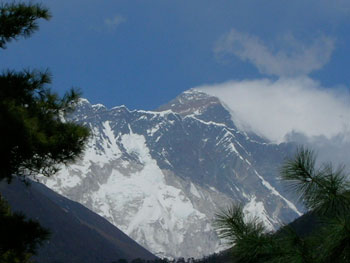Sagarmatha National Park
Area: 1148 sq km
Established: 1976
Location:
 Sagarmatha National Park was added to the list of World Heritage Sites in 1979 it is located 100kms northeast of Kathmandu in the Khumbu region of Nepal. The park contains the highest peak in the world, Sagarmatha (Mt Everest), along with several other well-known peaks Lhotse, Nuptse, Cho Oyu, Pumori, Ama Dablam, Thamserku, Kwangde, Kangtaiga and Gyachung Kang are among some of these. .
Sagarmatha National Park was added to the list of World Heritage Sites in 1979 it is located 100kms northeast of Kathmandu in the Khumbu region of Nepal. The park contains the highest peak in the world, Sagarmatha (Mt Everest), along with several other well-known peaks Lhotse, Nuptse, Cho Oyu, Pumori, Ama Dablam, Thamserku, Kwangde, Kangtaiga and Gyachung Kang are among some of these. .
Feature:
The mountains of Sagarmatha National Park are geologically young ,broken up by deep gorges and glacial valleys. Vegetation includes pine and hemlock forests at lower altitudes leading to fir, juniper, birch, rhododendron woods, scrub and alpine plant communities that grow below the bare rock and snow. Rhododendrons are in full bloom during spring (April and May.) The region is most plentiful in flora and colourful during the monsoon season (June to August).
Wild animals residing in the park are the Himalayan tahr, ghoral, serow and musk deer. The snow leopard and Himalayan black bear are also present but rarely sighted. Other smaller mammals that are found in the region include the weasel, maren, Himalayan mouse hare (pika), jackal and languer monkey.
The park is populated by approximately 3000 Sherpa people who originated from Tibet, their lives are heavily interwoven with the teachings of Buddhism. The main settlements are Namche Bazaar, Khumjung, Khunde, Thame, Thyangboche, Pangboche and Phortse. The economy of the Khumbu Sherpa community has traditionally been heavily based on trade and livestock herding. However, with the arrival of international mountaineering expeditions beginning in 1950s along with an ever increasing influx of foreign trekkers, today the Sherpa economy is becoming increasingly dependent on tourism.
Find Your Travel Mate
to cut down the cost
Come in a group and get special discounted price.
You will be regularly updated if anyone join into the program that you are intrested in.
Click here
to Write us

